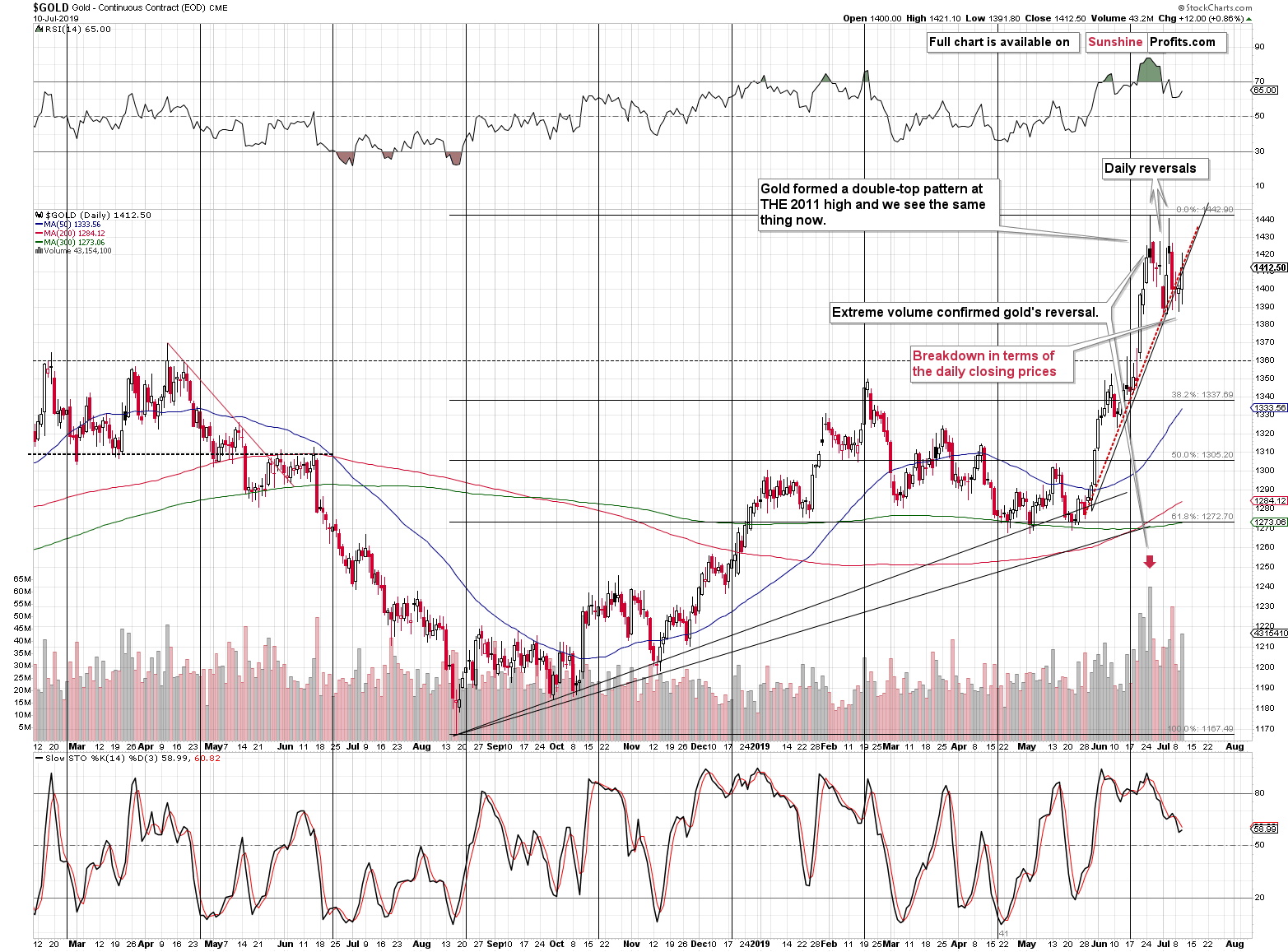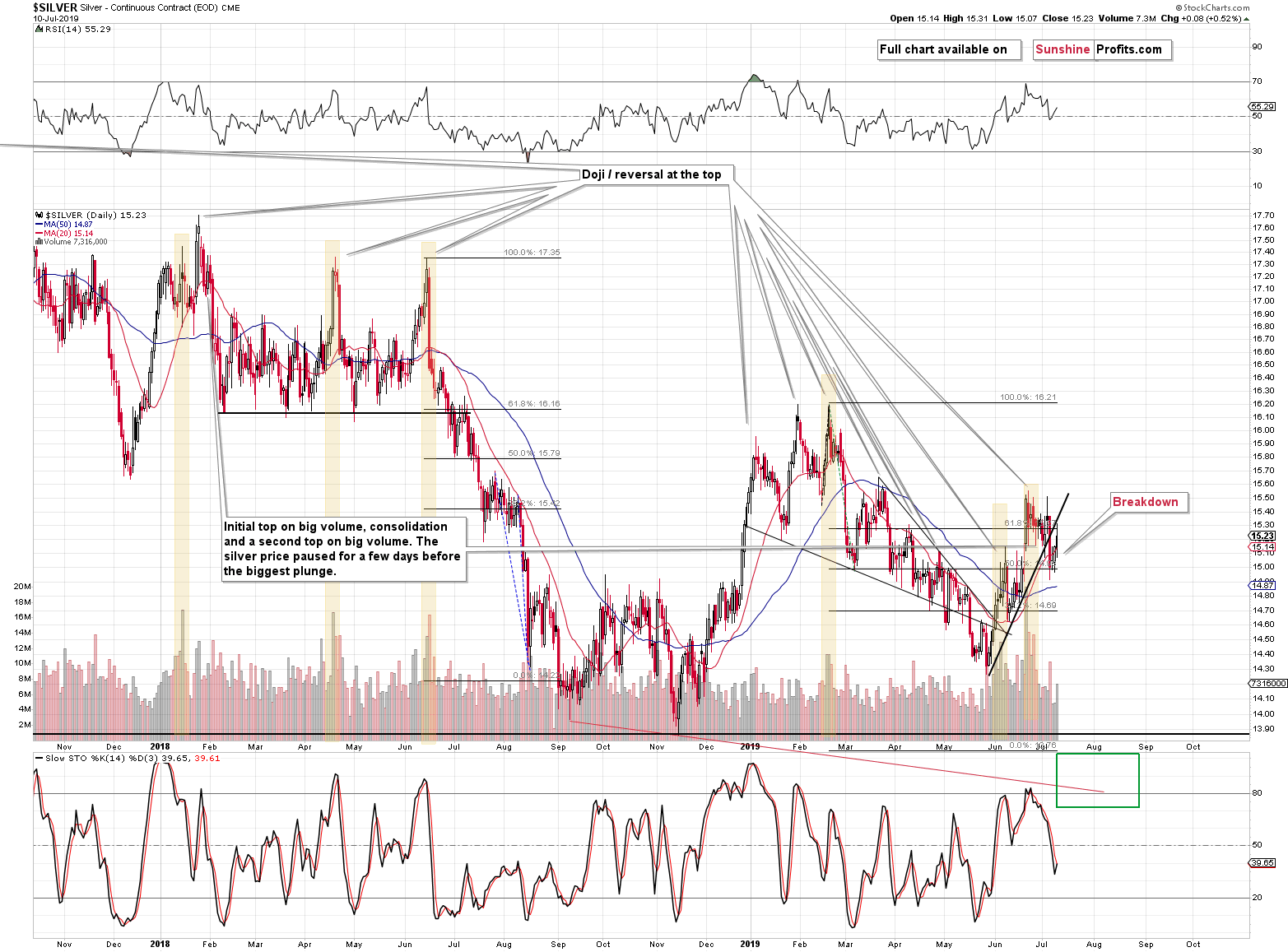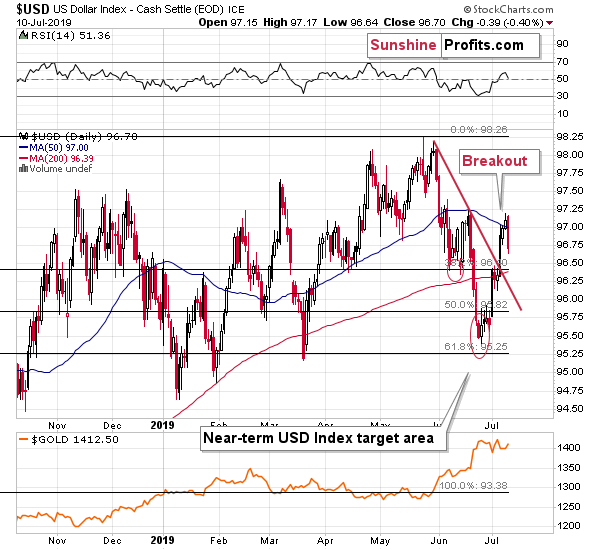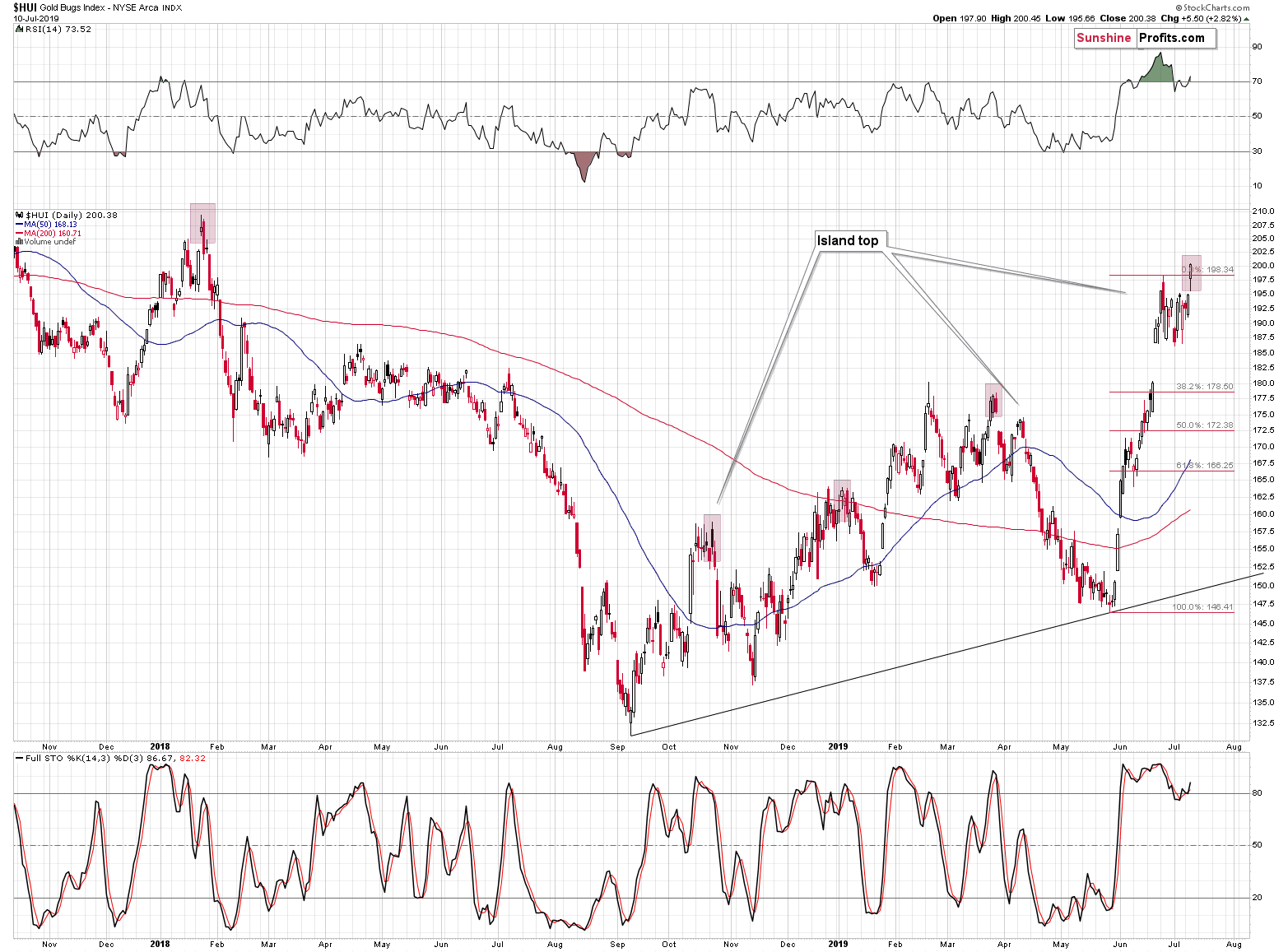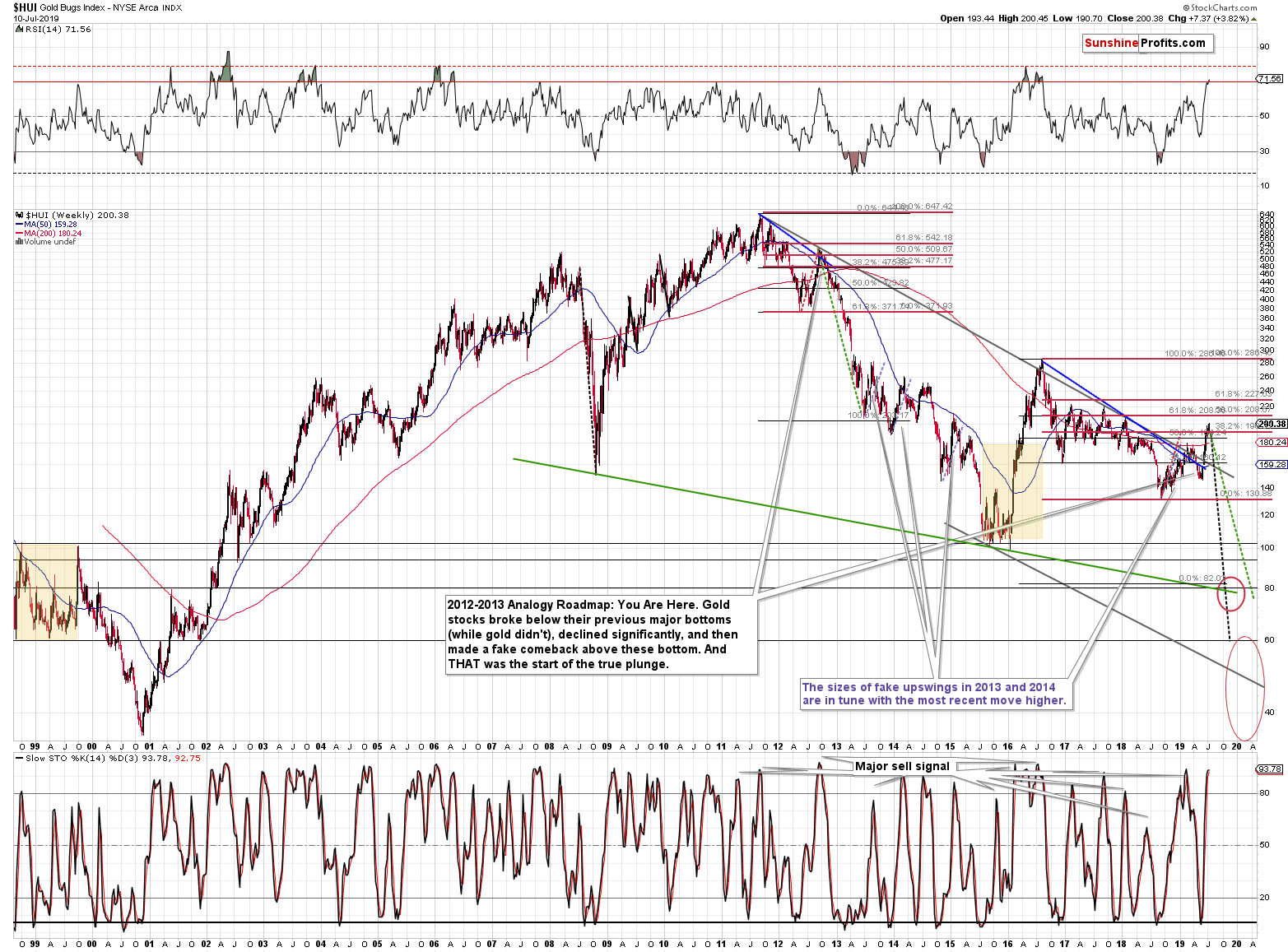Briefly: in our opinion, full (250% of the regular size of the position) speculative short position in gold, silver, and mining stocks are justified from the risk/reward perspective at the moment of publishing this Alert.
Gold has caught a bid yesterday and finished quite a few bucks higher. While this looks encouraging on its own, we better look at the entire precious metals complex, and the context of its moves. Wait, we have seen miners closing strongly yesterday. Does this point to a change in outlook, or we better take a valuable lesson from both gold and the miners' not so distant past?
Yesterday, we wrote about gold's breakdown below the rising support line in terms of the closing prices. Despite early declines, gold ended yesterday's session higher. But did it end it well above the rising support line?
Gold Closes At That Line
It didn't. Gold closed more or less right at it after having gained about $12. So, what has actually happened? It seems that gold is confirming the breakdown. The investors are still hesitating to let go of gold given the increased focus on the Fed and its dovish comments. Yesterday's Fed Minutes triggered volatility without changing much - if anything - fundamentally. Consequently, yesterday's price rally should not be taken at face value, and rather compared with the most recent price moves. Context is always the king, and in this case, it's not the move higher that matters on its own, but rather the fact that this move higher didn't cause gold to close back above the rising support line in terms of the closing prices. Unless gold rallies once again today, we will see gold below the rising support line and the breakdown will be confirmed.
The week ends tomorrow, and it will be important where the closing price is. If the above-mentioned breakdown is confirmed by the weekly closing price, it will be quite clear that gold's slide has already started.
We know that this back and forth trading at around (mostly above) $1,400 level is tiring, but please note that this may be viewed as something relatively normal as far as double tops are concerned.
Gold has been moving back and forth above $1,400 for a bit longer than two weeks now. In 2011, gold has been moving back and forth above $1,800 for more than 4 weeks before declining back below $1,600. So even if this back and forth action took twice as much time right now (which is doubtful), it would only match the topping time that we saw in 2011. We don't know if you remember the overall "feeling" back then - people were practically religiously convinced that gold will soar above $2,000 and that this back and forth movement was just a correction. Similarly, there are quite many people right now who are convinced that gold is going to shoot above $1,500 soon.
All in all, gold's yesterday's upswing seems to have been just a post-breakdown corrective upswing. And what did we see in silver?
Silver's Only Tests Its Line
Practically the same thing, only clearer. Silver had broken below its own rising support line earlier and it already confirmed the breakdown by closing below the line for three subsequent trading days. Yesterday's upswing was just a move back up and a verification of the breakdown. Some traders call it a "goodbye kiss" to the previous support. Whether one calls it that, or a final verification of the breakdown, the implications are still bearish. It's nothing more than a regular technical development that is a part of moving from a short-term uptrend to a short-term downtrend; and it suggests that silver is already in the latter.
We see a mirror image of the above in the USD Index.
The USD Index Correcting Its Breakout
In this case, it is the breakout that is being corrected. The USD Index didn't move back to the support line, but please note that it doesn't have to move to it. If USD continues to decline (and it did move lower today), then it's unlikely to slide below 96.1 or so. It could continue to rally any day now, though.
Given that USDX already moved about 0.2 lower in today's pre-market trading, the remaining downside is about 0.4 below the current USDX value. It could be the case that gold moves higher today only to slide back lower on Friday, similarly to what it did last week. This time, however, the above action would be a confirmation of the critical short-term breakdown in gold. It would therefore not be the same thing all over again, but rather something much more bearish.
There's one more thing that we would like to discuss today that you might be wondering about - the higher close in the gold stocks.
Gold Stocks Action Explained
Is it a breakout? It definitely is. But is it meaningful? One thing is that it has not confirmed, and the other thing is that we saw four similar cases in the past 1.5 years. We marked them with red rectangles - gold miners moved above the previous highs temporarily or even closed above them before the most sizable declines.
The move above the previous highs and the close at about 200 level may seem indeed encouraging at first sight, but it just doesn't add up with gold's and silver's breakdowns, and the USD breakout. Our yesterday's comments on miners' "strength" remain up-to-date, especially the analogy to what happened in early 2016:
One interpretation is that the mining stocks are showing strength here. Second one is that this is the final part of the topping formation where we see fake strength (similarly to the fake weakness in miners that we saw right before the powerful 2016 rally). It's unclear which of these interpretations is the correct one at this time, so it's better not to focus on this factor until it becomes clearer. In the bullish case, the above could take the form of a breakout above the previous highs, confirming that breakout. This is unlikely. Please note that in October 2018, when miners also formed the island top, miners moved practically right to the previous high before sliding in a volatile manner. It's not uncommon for miners to "act tough" until the end. But when they give up, they drop hard.
We received a question from one of our subscribers about the nature of the "ongoing strength in senior gold stocks". In particular, the question was if it was a matter of good news in individual miners, or something more fundamental.
In our view, it's neither. Gold mining stocks are moving higher as they virtually have to as the price of the product that they are selling is going up and moving above previous years' highs.
As much as we don't like to reply to a question with a question, this seems justified here. And our question is:
What strength?
Even taken together, this and last years' rally in the gold miners is very small to compare to the 2016 upswing, let alone to the enormous 2011 - 2016 decline. It's just a relatively small correction within a much bigger downtrend. By being bearish here, we are not against the major trend - we are in tune with it.
Some may say that the HUI Index broke above the very long-term declining resistance line based on the 2011 and 2012 tops, which makes the outlook bullish. However, they forget that the same thing happened at the very top that we saw in 2016. And they forget that given where gold is right now (above its 2016 high) the size of the recent upswing in the miners is very weak.
The current move is much more similar to the 2014 or 2015 corrective upswings than it is to the 2016 rally or to the beginning of the 2000s bull market. And what followed the 2014 and 2015 corrections? Big slides during which miners didn't look back until they reached new lows.
The more fundamental thing about all this that was mentioned in the question is that the miners are suggesting that this is not the beginning of a new powerful upswing that would take gold much higher eventually. It strongly indicates that we will need to see a bigger price decline first.
There's one more thing that we would like to add about the HUI's long-term chart. Please take a look at the rally that we saw right before the late 2012 top that directly preceded the biggest decline in the miners of the last several decades. It was not as big as the current upswing, but it was only a little smaller (of course percentage-wise - in absolute terms, the previous rally was much bigger). But when we compare both to the sizes of the preceding downswings (the 2011-2012 decline and the 2016-2018 decline), we see that the current rally is a bit smaller.
The previous upswing corrected a bit over 50% of the preceding decline, and the current upswing corrected a bit over 38.2% of the preceding decline (and bit less than 50%). The final part of the late-2012 upswing was similarly sharp as the current upswing is. However, while the late-2012 top in gold was very close to its late-2011 top, we definitely can't say the same thing about the HUI high. In late 2012, gold miners topped almost 100 index points below the late-2011 top. That's very similar to what's happening here. Gold moved to the previous high but failed to break above it (the late-2013 high that is), but gold miners were not even close to the analogous price level (it's about 80 index points higher). The history rhymes and this similarity has very bearish implications for the following weeks and months and the current strength appears to be just a correction within a bigger downtrend.
Summary
Summing up, gold and silver appear to be showing strength, but they are both actually confirming their breakdowns below their rising short-term support lines, which makes the current price action bearish, not bullish. Let's keep in mind that the yellow metal did so after once again failing to break above the mid-2013 high, and shortly after silver broke below its own rising support line, which means that the overall outlook for the precious metals market deteriorated. The above happened after multiple long-term signs pointing to lower prices in the following months, i.a. the clear huge-volume-confirmed bearish shooting star candlestick in gold, huge volume topping signs from both: gold and silver, the triangle-vertex-based reversals, and epic volume from silver stocks. The next big move in the precious metals sector is most likely going to be down, not up.
As always, we'll keep you - our subscribers - informed.
To summarize:
Trading capital (supplementary part of the portfolio; our opinion): Full short position (250% of the full position) in gold, silver, and mining stocks is justified from the risk/reward perspective with the following stop-loss orders and exit profit-take price levels:
- Gold: profit-take exit price: $1,241; stop-loss: $1,452; initial target price for the DGLD ETN: $51.87; stop-loss for the DGLD ETN $31.67
- Silver: profit-take exit price: $13.81; stop-loss: $16.32; initial target price for the DSLV ETN: $39.38; stop-loss for the DSLV ETN $23.87
- Mining stocks (price levels for the GDX ETF): profit-take exit price: $17.61; stop-loss: $26.47; initial target price for the DUST ETF: $34.28; stop-loss for the DUST ETF $9.87
In case one wants to bet on junior mining stocks' prices (we do not suggest doing so - we think senior mining stocks are more predictable in the case of short-term trades - if one wants to do it anyway, we provide the details), here are the stop-loss details and target prices:
- GDXJ ETF: profit-take exit price: $24.71; stop-loss: $37.17
- JDST ETF: profit-take exit price: $78.21 stop-loss: $22.47
Long-term capital (core part of the portfolio; our opinion): No positions (in other words: cash)
Insurance capital (core part of the portfolio; our opinion): Full position
Whether you already subscribed or not, we encourage you to find out how to make the most of our alerts and read our replies to the most common alert-and-gold-trading-related-questions.
Please note that the in the trading section we describe the situation for the day that the alert is posted. In other words, it we are writing about a speculative position, it means that it is up-to-date on the day it was posted. We are also featuring the initial target prices, so that you can decide whether keeping a position on a given day is something that is in tune with your approach (some moves are too small for medium-term traders and some might appear too big for day-traders).
Plus, you might want to read why our stop-loss orders are usually relatively far from the current price.
Please note that a full position doesn't mean using all of the capital for a given trade. You will find details on our thoughts on gold portfolio structuring in the Key Insights section on our website.
As a reminder - "initial target price" means exactly that - an "initial" one, it's not a price level at which we suggest closing positions. If this becomes the case (like it did in the previous trade) we will refer to these levels as levels of exit orders (exactly as we've done previously). Stop-loss levels, however, are naturally not "initial", but something that, in our opinion, might be entered as an order.
Since it is impossible to synchronize target prices and stop-loss levels for all the ETFs and ETNs with the main markets that we provide these levels for (gold, silver and mining stocks - the GDX ETF), the stop-loss levels and target prices for other ETNs and ETF (among other: UGLD, DGLD, USLV, DSLV, NUGT, DUST, JNUG, JDST) are provided as supplementary, and not as "final". This means that if a stop-loss or a target level is reached for any of the "additional instruments" (DGLD for instance), but not for the "main instrument" (gold in this case), we will view positions in both gold and DGLD as still open and the stop-loss for DGLD would have to be moved lower. On the other hand, if gold moves to a stop-loss level but DGLD doesn't, then we will view both positions (in gold and DGLD) as closed. In other words, since it's not possible to be 100% certain that each related instrument moves to a given level when the underlying instrument does, we can't provide levels that would be binding. The levels that we do provide are our best estimate of the levels that will correspond to the levels in the underlying assets, but it will be the underlying assets that one will need to focus on regarding the signs pointing to closing a given position or keeping it open. We might adjust the levels in the "additional instruments" without adjusting the levels in the "main instruments", which will simply mean that we have improved our estimation of these levels, not that we changed our outlook on the markets. We are already working on a tool that would update these levels on a daily basis for the most popular ETFs, ETNs and individual mining stocks.
Our preferred ways to invest in and to trade gold along with the reasoning can be found in the how to buy gold section. Additionally, our preferred ETFs and ETNs can be found in our Gold & Silver ETF Ranking.
As a reminder, Gold & Silver Trading Alerts are posted before or on each trading day (we usually post them before the opening bell, but we don't promise doing that each day). If there's anything urgent, we will send you an additional small alert before posting the main one.
=====
Latest Free Trading Alerts:
Hot Wednesday is behind us. We had both the Powell's testimony to the Congress and the released minutes from the latest FOMC meeting. The biggest yesterday's winner is clearly gold. If you would like to know why - and what situation the yellow metal is in currently - we invite you to read our today's article!
Powell Testimony Propels Gold Above $1,400 - the Countdown to July's FOMC Is On
The S&P 500 index has reached new record high above the 3,000 mark on Wednesday, before closing slightly below the last week's local high. Will the uptrend continue? Or is this some topping pattern ahead of a downward reversal?
Stocks Reach New Records, but Is There Any Room Left?
=====
Thank you.
Sincerely,
Przemyslaw Radomski, CFA
Editor-in-chief, Gold & Silver Fund Manager


